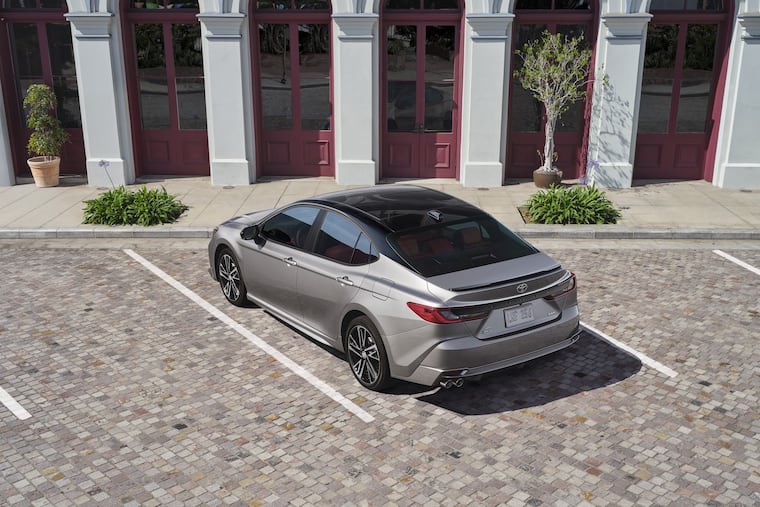2025 Toyota Camry: Top seller moves ahead with new look, new power train
There’s nothing like a midsize hybrid sedan to combine space, a smooth ride, and great fuel efficiency. Here’s the latest incarnation of the popular Toyota.

2025 Toyota Camry AWD XSE vs. 2025 Hyundai Sonata Hybrid Limited: Sedans with some space that sip fuel.
This week: Toyota Camry Hybrid
Price: $44,569 as tested. Premium Plus Package added a slew of safety features, JBL audio system, ventilated front seats, and more for $4,075; 19-inch wheels, $1,500; special color and black roof totaled $925; funky exterior lighting added $849 total.
Conventional wisdom: Car and Driver likes the “more powerful hybrid setup, impressive fuel efficiency, pleasant interior upgrades,” but not the “numb steering,” that there’s “no more V-6 engine option,” or that “some driver-assist features are costly options.”
Marketer’s pitch: “Every day deserves more fun.”
Reality: Once upon a time, the above sentiment was the mantra for owners ready to trade in their Camry. How about now?
What’s new: The Camry sedan goes the way of the Prius for 2025, coming only in hybrid form (no PHEV available, though). Fortunately I’d tested a 2024 Camry Hybrid, which offers the same specs — the Camry received interior and exterior redesigns for 2024.
Competition: In addition to the Sonata Hybrid, there’s the Honda Accord Hybrid and Toyota Prius among hybrid models. Comparing to sedans adds the Accord, Kia K5, Nissan Sentra, and Subaru Legacy.
Up to speed: We expect these sedans to go easy on the fuel, but the Camry tested was also no slouch. The all-wheel-drive version gets two motors enhancing the 2.5-liter four-cylinder’s power, bringing the total horses up to 232. (The front-wheel-drive version only has one motor.)
The Camry gets to 60 mph in 6.8 seconds, according to Car and Driver. That puts it on the doorstep of quick, if not exactly inside the front hall.
Still, even with all that power at my disposal, I have to confess the Camry Hybrid lent itself to driving sedately. Maybe that’s not such a bad thing, which I do adjust once in a while. (I occasionally drive my own cars, too.)
Shifty: The Camry Hybrid gets a normal shifter instead of the Prius joystick that’s all over the Toyota lineup these days. You can control gears but that’s all, no real shifter action.
On the road: The XSE versions of Toyotas have boosted performance nicely, and the Camry is no exception. The short, squat tires offer great hold when the map lines start to turn into scribbles, but I’d bet winter performance is compromised (but then, hey, all-wheel drive). Still, it was June and the weather was beautiful, and how many times can you say, “Yeehaw, Camry, fun ride!”
Highway performance was nice as well, without a lot of shaking over road seams and such.
Driver’s Seat: Ooooh, this Camry gets the Lexus treatment. Bright red seats and dashboard in leather make for a sharp interior look, though it has its detractors. (He looks toward the passenger seat and sees Mrs. scowling.)
I’ve not quite become one with the new Toyota-Lexus dashboard display adjustment. There’s something I hit and then an outline of what looks like a rearview mirror comes up with a 1, 2, or 3 in it. Things randomly slide from side to side. I shouldn’t still be this confused after all the Toyotas.
I eventually got it to show me what I wanted, but I couldn’t explain quite how. So this is not quite a win.
Also the simple, intuitive Toyota cruise-control stalk is gone, and only sadness and longing remain.
The video monitoring system can be a pain, always announcing that it can’t see me because my hands get in the way. But I’m glad it’s watching you, and you, and especially him over there; I, of course, don’t need it.
Friends and stuff: Rear-seat passengers will find accommodations less than ideal. Tall Sturgis Kid 4.0 complained the seat lacked headroom. Legroom and foot room were OK.
A seat belt that kept getting stuck on the plastic clip that holds it in place became an every-drive annoyance.
Cargo space is 15.1 cubic feet, and the rear seat folds down for passing through long items.
Play some tunes: The nine-speaker JBL stereo in the model tested provided some of the clearest playback I’ve heard in a while. (I’m of a certain age where I worry it’s my hearing, but everything still sounds perfect on the home sound bar, so not yet.) I’d call this an A+ for bringing out a broad array of chords, notes, and instruments normally lost to listeners.
Operation of the system is simple enough, with a volume dial and everything else in the fairly easy 12.3-inch touchscreen.
Keeping warm and cool: A row of toggles control almost all the functions. The seat heaters and coolers are buttons that sit directly above the toggles next to the temperature readout, so I was forever hitting the wrong toggle when I wanted to change the seat cooling. I imagine buyers figure this out after a few weeks.
The vents were hard to direct as well so there seemed to be a lot of air in my face.
Fuel economy: I averaged around 36 mpg in a rather sedate round of testing.
Where it’s built: Georgetown, Ky.
How it’s built: Consumer Reports predicts the Camry to rate about a 3 out of 5 in reliability, its worst rating since 2017.
Next week: Hyundai Sonata Hybrid